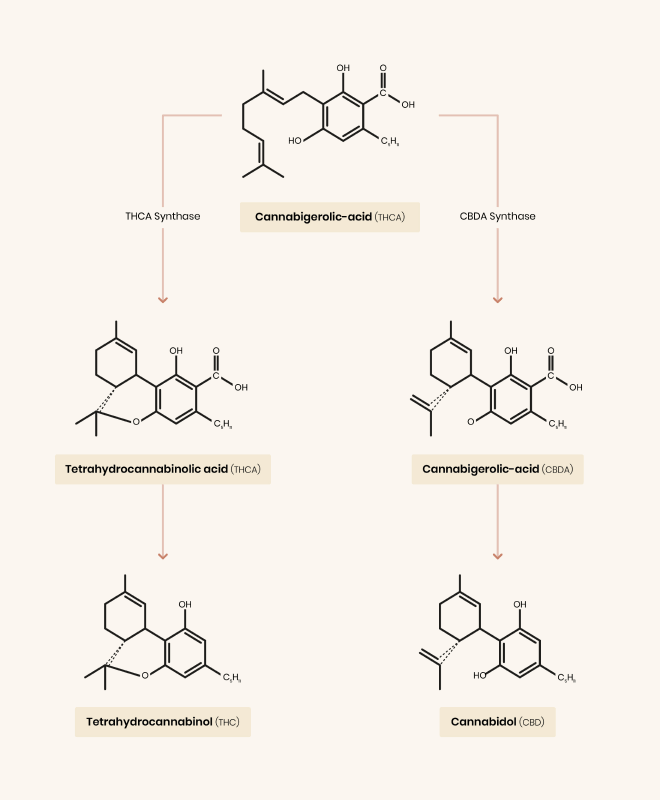How cannabis works
Cannabis is an effective treatment for some conditions because of the presence of cannabinoids and other chemical compounds, which naturally interact and modulate the human body’s own endocannabinoid system. This system of neurotransmitters found throughout the central and peripheral nervous system performs vital regulatory processes. It affects a wide range of functions, from immune response to cell signalling, sleep, appetite, mood and considerably more.

Plant compounds
One of the primary differences between front line pharmaceutical drugs and cannabis-based medicinal products (CBMPs) is their complexity. While manufactured treatments are often an isolated single molecular compound designed to target a highly specific pathogen or condition, the organic plant compounds found in cannabis (phytocannabinoids) naturally interact with the network of endocannabinoids, receptors and enzymes within the human body known as the endocannabinoid systems (ECS).

The compounds found most abundantly in most cannabis strains are the relatively well known delta-9-tetrahydrocannabinol (THC) and cannabidiol (CBD), but there are over 100 different compounds, some with opposing effects, altogether forming some of the approximately 400 chemical entities that compose the cannabis plant.


While the clinical value of several compounds is known, notably with regards to THC and CBD, investigation into the medicinal potential of many of the lesser cannabinoids continues with the expectation that each may provide unique therapeutic pathways. Secondary metabolites like THCA, CBN and CBG, among others, are being identified as potentially effective treatments for a range of conditions not addressed by the major cannabinoids.
The complexity of the plant, however, is more than just in its chemical composition, and a major area of investigation is in the combined therapeutic impact of more than one or many cannabinoid compounds acting together, often referred to as the “entourage effect”.
The Endocannabinoid System
The Endocannabinoid System (ECS) is a complex cell-signalling system and is present throughout the human body, in the brain, the central nervous system, the lungs, bones, gut and muscles. This in part explains the far reaching clinical potential of cannabis, as there is very little part of the body that its compounds don’t interact with. As such, it plays a role in the regulation of sleep, mood, appetite, memory, reproduction, fertility and much more.

The three key components of this system are endocannabinoids (cannabinoids naturally synthesized in the human body), receptors and enzymes.
The key endocannabinoids identified to date are anandamide (AEA) and 2-arachidonoylglycerol (2-AG). These are naturally produced and metabolised in the body and play an array of vital regulatory functions, binding to our natural cannabinoid receptors.
Our primary cannabinoid receptors are known as CB1 and CB2 receptors, interaction with which yields different responses due in part to their distinct distribution in the body. CB1 receptors are found within the peripheral and central nervous systems, while CB2 receptors are found with greater abundance in the gastrointestinal and immune systems.
The final component of the ECS are the enzymes that break down endocannabinoids once they have performed their signalling functions. These are fatty acid amide hydrolase, which breaks down AEA, and monoacylglycerol acid lipase, which typically breaks down 2-AG.
How the plant works in the body
While the ECS constantly plays an important regulatory function in the body, with some suggestions that its principle overall benefit is in maintaining homeostasis, the introduction of exogenous cannabinoids found in the cannabis plant (phytocannabinoids) provides a further array of clinical benefits. To date, research has identified potential value in the treatment of a number of conditions.

Much as there is complexity in the organic compounds that form the cannabis plant, the pharmacology of these compounds, how they interact with the ECS, is highly complex. In simple terms, cannabinoids bind with our ECS receptors to mediate cell-signalling, a fundamental aspect of proper biological function.
While THC does interact with both CB1 and CB2 receptors, where mediation notably provides THC’s widely reported psychoactive effects, CBD does not demonstrate any significant activity with them and yet still activates antiepileptic, anxiolytic, antipsychotic, anti-inflammatory, and neuroprotective effects.
In combination, notably in treating conditions like epilepsy, the therapeutic value of THC and CBD is significantly increased, giving rise to the “entourage effect” theory of medical cannabis.
Registered address:
Eprescriptions Ltd t/a Dispensary Green
Unit 3, Sherwood Energy Village, Newton Hill, New Ollerton
NG22 9FD




